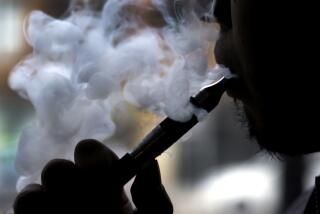Philip Morris Is Testing a New Low-Tar Cigarette
- Share via
Philip Morris Cos. has begun test marketing a new low-nicotine cigarette manufactured with a technological innovation designed to ensure a taste virtually identical to standard cigarettes, industry sources said Wednesday.
The giant food, beverages and tobacco concern is distributing the cigarette--containing about 0.1 milligram of nicotine--by mail to selected smokers with a questionnaire asking if they would buy the product if it were on the market, according to Advertising Age, the trade publication that first reported the testing program.
Philip Morris declined comment. A spokeswoman said the company’s policy is never to comment on new product testing. However, analysts said enough people have seen the cigarette--tentatively called Merit Free and Next from Merit--to confirm the basics of the program. Philip Morris’ Merit brand is the best-selling low-tar cigarette. It has 0.6 milligram of nicotine.
Although there are products on the market with the same low-nicotine content, the new Philip Morris program is seen as a move by the company to maintain its market share lead in an overall shrinking pool of smokers. It also reflects a tacit acknowledgement by cigarette makers that consumers are afraid of cigarettes, although the manufacturers are careful not to concede that cigarettes are a health problem, analysts said.
Must Boost Share
With overall domestic cigarette consumption continuing to decline, the name of the game for cigarette manufacturers is to come up with innovations that will boost their market share, said Lawrence Adelman, an analyst with Dean Witter. Philip Morris, the leading cigarette manufacturer with 39.6% of the total cigarette market, “is really the only one doing that,” he added.
RJR Nabisco attempted to grab the technological prize with its ill-fated Premier “smokeless cigarette,” which was introduced with a great deal of fanfare in 1987 but yanked out of test markets earlier this year. However, Philip Morris appears to be moving more slowly with its project and avoiding the kind of radical product changes that doomed Premier. Premier, which contained a tobacco flavored capsule, ultimately failed because consumers didn’t like the taste. And RJR also drew a lot of unfavorable publicity by designing a product that anti-smoking groups seized upon as a “drug-delivery device” and pressured the Food and Drug Administration to regulate.
While cigarette smoking is declining overall, there has been a shift among brands, particularly benefiting the low-tar, low-nicotine products, said Dave Stewart, a professor of marketing at the University of Southern California. “Any cigarette that is perceived as healthier will pull from those brands,” he said.
Such a cigarette wouldn’t be a general market product but would appeal to smokers who would like to quit smoking because they are concerned about their health yet have not been able to kick the habit, he said.
“I don’t know how sizable that market is, but it could be 20% to 25% of smokers,” Stewart said. But, he added, the key for Philip Morris is to deliver on the promise of a technological innovation that will both produce the lowest level of nicotine and provide the taste that will appeal to smokers.
Philip Morris, reportedly, has modified the process its General Foods USA subsidiary uses to decaffeinate coffee. The company is said to have been working on the project since 1985 when it acquired General Foods, which manufactures Maxwell House coffee.
The low-nicotine cigarettes currently on the market use methods such as highly porous paper and special filters to reduce the tar and nicotine content, industry sources said. But the process changes the taste of cigarettes.
The basic coffee decaffeination process is some form of a cold water extraction, aided by certain chemicals--commonly methylene chloride and ethyl acetate. The chemicals bond with the caffeine in the beans and extract it without changing the taste.
If the process is successful with the proposed new Merit line, Philip Morris is expected to reduce nicotine in other brands, including Marlboro, the leading brand with a 25% market share.
Although reports about the Philip Morris project attracted attention, industry analysts tempered their enthusiasm. “It’s in the concept testing stage. There is a lot to be explored here,” said Diana K. Temple, an analyst with Salomon Brothers in New York.
“I’m not making too much of it,” Adelman said. “I think it’s just a probe. There are other (similar) products on the market. They may have a better version of it (the low-nicotine cigarette). But Philip Morris is doing a lot of interesting things. They just introduced a new Marlboro ultra low-tar product. I think this is a function of Philip Morris becoming even more dominant in the market,” he added.
Although Philip Morris appears to be moving cautiously with its tests, any cigarette marketing innovation is bound to have its detractors. Health officials and anti-smoking groups haven’t tempered their criticisms of low-tar and low-nicotine cigarettes, and vigorously contest any perception that they are safer.
“Health-wise, it won’t provide huge benefits because cigarettes have tar and carbon monoxide and a lot of other things that cause cancer. The chief effect will be to make these cigarettes less addictive,” said Dr. Ronald Davis, director of the U.S. Office on Smoking and Health.
Some health officials even argue that low-nicotine cigarettes are more threatening because smokers tend to smoke more to get the same “nicotine rush,” said Joe Tye, president of Stop Teen-age Addiction to Tobacco.
More to Read
Inside the business of entertainment
The Wide Shot brings you news, analysis and insights on everything from streaming wars to production — and what it all means for the future.
You may occasionally receive promotional content from the Los Angeles Times.










